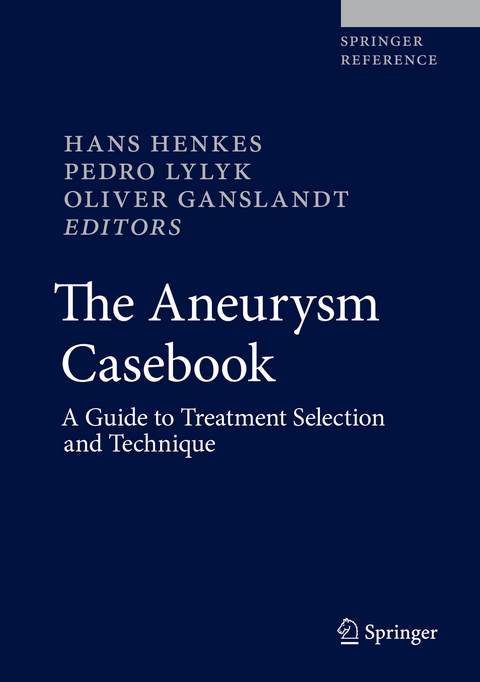
The Aneurysm Casebook
Springer International Publishing
978-3-319-77826-6 (ISBN)
Hans Henkes is Professor of Neuroradiology and Medical Director of the Neuroradiological Clinic at Klinikum Stuttgart, Stuttgart, Germany. He graduated from the Freie Universität Berlin in 1985. After residencies in Neurophysiology and General Radiology at the University Hospital Berlin-Charlottenburg (1985-1991) and Neuroradiology at the University Hospital Homburg/Saar (1991-2), he received board certification for Radiology and Neuroradiology in 1991 and 1993, respectively. From 1991 through 2006 he worked at the Department of Radiology and Neuroradiology at the Alfried Krupp Krankenhaus Essen, Germany, under Professor Dietmar Kühne. In 1999 he received the venia legendi for Neuroradiology from the Medical Faculty of the University Duisburg-Essen. Dr. Henkes took up his present position in 2007. He is responsible for more than 1200 endovascular treatments annually. He has published over 240 papers in peer-reviewed journals and holds over 60 patents in the neuroendovascular field. Pedro Lylyk is Chairman of the Endovascular Neurosurgery and Interventional Radiology Institute "ENERI" (Equipo de Neurocirugía Endovascular y Radiología Intervencionista), with clinical responsibilities for the Neuroradiology Section in the Radiology Division and the Neurointerventional Division in the Department of Clinical Neurosciences. Dr. Lylyk's academic activity focuses on translational research in the field of image-guided minimally invasive treatment of neurovascular diseases, tumors, and back pain. He holds a variety of professorial positions, including at the University of Buenos Aires, Universidad del Salvador (Buenos Aries), and University of Santiago de Compostela (Spain). Dr. Lylyk is co-founder of the International Intracranial Stent Symposium (ICS), co-founder and past President of the Latin American Society of Diagnostic and Interventional Neuroradiology (SILAN), co-founder and past President of the Argentine Association of Diagnostic and Therapeutic Neuroradiology (AANDiT), and Chairman of the Argentine Stroke Association (AAS). Oliver Ganslandt graduated from medical school at Friedrich-Alexander University Erlangen-Nuremberg, Germany. He completed his doctoral thesis on the subject of magnetoencephalography in 1992 and gained his Habilitation in 2002 for work on functional neuronavigation. His education as a neurosurgeon began in 1991 under Prof. R. Fahlbusch at the Department of Neurosurgery in Erlangen and continued under Prof. M. Buchfelder. He worked as vice chairman of that department until January 2014 and was then elected as chairman of the Department of Neurosurgery in Stuttgart, where he works today. His clinical and scientific interests are vascular neurosurgery, functional imaging, neurooncology, and radiosurgery. He has contributed numerous presentations at national and international meetings and serves as a reviewer for many peer-reviewed journals (including Neurosurgery and Journal of Neurosurgery) as well as various national and international scientific organizations. He is a member of the advisory board of the journal Strahlentherapie und Onkologie.
Part 1: Cervical Artery;- Part 2: Petrous internal carotid artery;- Part 3: Cavernous internal carotid artery;- Part 4: Paraophthalmic internal carotid artery;- Part 5: Ophthalmic artery;- Part 6: Superior hypophyseal artery;- Part 7: Supraclinoid internal carotid artery;- Part 8: Posterior communicating artery;- Part 9: Anterior choroidal artery;- Part 10: Internal carotid artery bifurcationn;- Part 11: Proximal segment (A1) of the anterior cerebral artery;- Part 12: Azygos anterior cerebral artery;- Part 13: Anterior communicating artery;- Part 14: Pericallosal artery;- Part 15: Proximal segment (M1) of the middle cerebral artery;- Part 16: Lenticulostriate artery;- Part 17: Bifurcation of the middle cerebral artery;- Part 18: Distal segments (M2 and beyond) of the middle cerebral artery;- Part 19: Vertebral artery (V4);- Part 20: Vertebral artery junction;- Part 21: Basilar artery trunk;- Part 22: Pontine perforator artery;- Part 23: Basilar artery bifurcation;- Part 24: Posterior inferior cerebellar artery aneurysm;- Part 25: Anterior inferior cerebellar artery;- Part 26: Superior cerebellar artery;- Part 27: Posterior cerebral artery;- Part 28: Dural artery;- Part 29: Spinal cord artery;-
| Erscheint lt. Verlag | 25.7.2020 |
|---|---|
| Reihe/Serie | The Aneurysm Casebook |
| Zusatzinfo | L, 1618 p. 731 illus., 308 illus. in color. In 2 volumes, not available separately. |
| Verlagsort | Cham |
| Sprache | englisch |
| Maße | 178 x 254 mm |
| Gewicht | 3580 g |
| Themenwelt | Medizin / Pharmazie ► Medizinische Fachgebiete ► Neurologie |
| Medizinische Fachgebiete ► Radiologie / Bildgebende Verfahren ► Radiologie | |
| Schlagworte | Antiaggregation • anticoagulation • Balloon Remodeling • Bifurcation Stenting • Case Studies in Aneurysm Treatment • Coil occlusion • Extra- and Intrasaccular Flow Diversion • Intracranial Aneurysms • Intrasaccular Flow Disruption • Liquid Embolic Agents • Parent Vessel Occlusion • subarachnoid hemorrhage • Surpass, FRED, p64 |
| ISBN-10 | 3-319-77826-9 / 3319778269 |
| ISBN-13 | 978-3-319-77826-6 / 9783319778266 |
| Zustand | Neuware |
| Haben Sie eine Frage zum Produkt? |
aus dem Bereich

